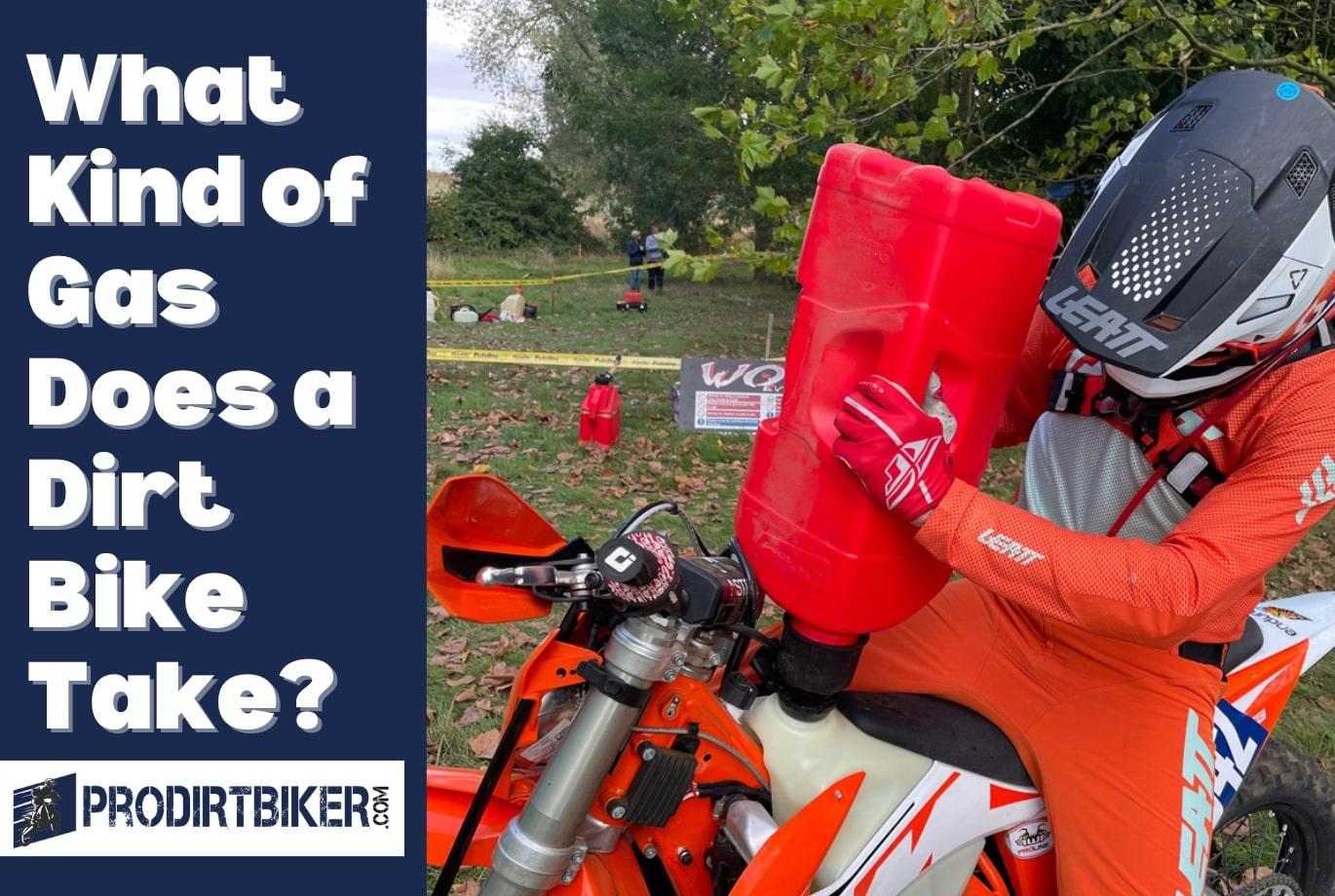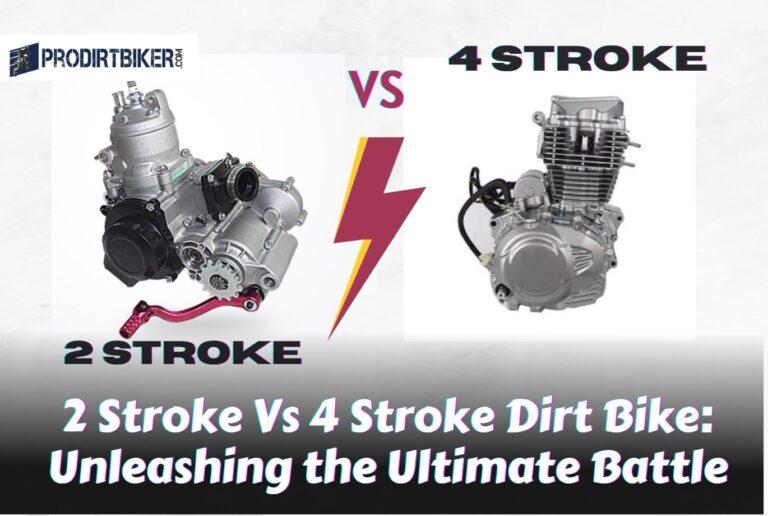What Kind of Gas Does a Dirt Bike Take? Unveiling the Fuel Secrets

If you’re new to the world of dirt biking, you may be wondering what kind of gas your bike takes. After all, using the wrong type of fuel can cause serious damage to your engine and affect your bike’s performance.
In this blog post, we’ll cover everything you need to know about the type of gas that is recommended for dirt bikes. We’ll discuss the differences between regular gasoline and race fuel, as well as provide tips on how to properly fuel up your bike for optimal performance. So if you want to keep your dirt bike running smoothly and efficiently, read on to learn more about the best gas for your ride.
What Kind of Gas Does a Dirt Bike Take?
A dirt bike takes regular unleaded gasoline as fuel for its engine. Dirt bikes, popular among motocross and off-road enthusiasts, require a specific type of fuel to function properly.
Dirt bikes typically require a specific type of gasoline to run efficiently and avoid engine damage. The type of gas a dirt bike takes is typically regular unleaded gasoline with an octane rating of 87 or 91 (research octane number, or RON) depending on the bike’s engine specifications. However, it’s crucial to consult your dirt bike’s owner’s manual or check the manufacturer’s recommendations to ensure you are using the correct fuel.
In some cases, high-performance dirt bikes with advanced engines may require higher-octane fuel, such as premium unleaded gasoline with an octane rating of 91 or higher. Using the wrong type of fuel can lead to engine knocking, reduced performance, and potential long-term damage.
Additionally, it’s essential to avoid using ethanol-blended fuels with a high ethanol content, such as E15 or E85, in your dirt bike. Ethanol can absorb moisture, which can lead to fuel system problems and engine issues, particularly if the bike is not used frequently.
To maintain the optimal performance and longevity of your dirt bike, always follow the manufacturer’s recommendations for fuel type and avoid using fuel that contains more ethanol than what is specified in the manual. Regular maintenance, including cleaning the fuel system, can also help keep your dirt bike running smoothly.
Understanding The Fuel Requirements Of Dirt Bikes
Dirt bikes are not only fun to ride but also require some special care and attention when it comes to fueling them up. Understanding the fuel requirements of dirt bikes is essential to ensure optimal performance and longevity of your beloved machine.
In this section, we will explore the importance of using the right fuel for your dirt bike, the factors influencing fuel choice, and the role of octane rating in determining the ideal fuel for your ride.
The Importance Of The Right Fuel
Using the right fuel for your dirt bike is crucial for several reasons:
- Performance: The correct fuel can enhance the overall performance of your dirt bike, providing you with a smoother and more powerful ride. It helps your engine to run smoothly, allowing you to make the most out of your off-road adventures.
- Engine longevity: Using the appropriate fuel can also contribute to the longevity of your dirt bike’s engine. The right fuel helps in reducing wear and tear, preventing premature engine failures, and ensuring that your bike stays in good condition for years to come.
- Fuel efficiency: By using the right fuel, you can optimize the fuel efficiency of your dirt bike. This means you can go further on a single tank, reducing the need for frequent refueling and saving some extra bucks in the process.
Factors Influencing Fuel Choice
When it comes to choosing the right fuel for your dirt bike, several factors come into play:
- Manufacturer’s recommendations: Always refer to your bike’s manufacturer’s recommendations regarding the type of fuel to use. Manufacturers know the engine requirements best and provide guidelines to optimize performance and avoid potential engine damage.
- Engine type: Different dirt bike engines have varying fuel requirements. Two-stroke engines, for example, typically require a mixture of gasoline and oil, while four-stroke engines usually run on gasoline alone. Make sure you understand your engine’s specifications to select the appropriate fuel.
- Altitude and temperature: The altitude and temperature of your riding location can also influence fuel choice. Higher altitudes may require different octane ratings due to the air density, and extreme temperatures may impact fuel combustion. Consider the environmental conditions when selecting the right fuel for your ride.

The Role Of Octane Rating
Octane rating plays a crucial role in determining the appropriate fuel for your dirt bike. The octane rating measures the fuel’s ability to resist knocking or pinging in the engine. Here’s what you need to know:
- Higher octane rating: If your dirt bike has a high-performance engine, it may require fuel with a higher octane rating. High-performance engines are more prone to knocking, and using a higher octane fuel can help prevent this issue.
- Lower octane rating: On the other hand, if your dirt bike has a lower compression ratio or is a standard model, a lower octane rating fuel should be suitable. Using a lower octane fuel in a high-performance engine, however, can lead to knocking and potentially damage the engine.
Understanding the fuel requirements of your dirt bike is essential for optimal performance and longevity. By using the right fuel, considering factors like manufacturer recommendations, engine type, altitude, and temperature, and understanding the role of octane rating, you can ensure a smooth and thrilling experience on your two-wheeled off-road adventures.
So, fuel up right and hit the dirt with confidence!
Different Types Of Fuel Compatible With Dirt Bikes
Dirt bikes are a thrilling way to explore the great outdoors. These powerful machines require fuel to run smoothly and efficiently. But what kind of gas does a dirt bike take? Let’s dive into the different types of fuel that are compatible with these off-road motorcycles.
Unleaded Gasoline: The Most Common Option
- Unleaded gasoline is the most commonly used fuel for dirt bikes.
- It contains no added chemicals or substances that could potentially harm the engine.
- With a higher octane rating, it provides better performance and prevents knocking.
- Unleaded gasoline is readily available at most gas stations, making it convenient for dirt bike riders.
Ethanol-Blended Gasoline: Pros And Cons
- Ethanol-blended gasoline contains ethanol, a type of alcohol made from corn or other plant sources.
- It is typically labeled as e10, indicating that it contains 10% ethanol.
- One of the advantages of ethanol-blended gasoline is that it is better for the environment and reduces greenhouse gas emissions.
- However, ethanol can absorb water, which may cause fuel system issues if left unused for long periods.
- Additionally, the lower energy content of ethanol can decrease the overall performance of the dirt bike’s engine.
Race Gasoline: Is It Worth The Investment?
- Race gasoline is a specialized fuel formulated specifically for high-performance engines.
- It typically has a higher octane rating than regular unleaded gasoline.
- The increased octane improves combustion and reduces the risk of engine knock or detonation.
- Race gasoline is commonly used in competition and professional racing, where every ounce of performance matters.
- However, for the average dirt bike rider, the added cost of race gasoline may not be worth the minimal performance gains.
Understanding the different types of fuel compatible with dirt bikes is crucial for maintaining the longevity and performance of your off-road machine. While most riders opt for unleaded gasoline due to its availability and reliability, some may experiment with ethanol-blended fuels or even race gasoline for that extra edge on the race track.
Ultimately, the choice of fuel depends on your specific needs and preferences as a dirt bike enthusiast. So fill up your tank and hit the trails with confidence!
Choosing The Right Fuel For Your Dirt Bike
Choosing the right fuel for your dirt bike is crucial to ensure optimal performance and longevity of your machine. It’s important to consider the manufacturer’s recommendations and consult the manual, as well as take into account the specific requirements of two-stroke and four-stroke engines.
Additionally, your personal riding style and performance goals play a role in the type of fuel that best suits your dirt bike. Let’s delve into each of these factors in more detail.
Manufacturer’S Recommendations And Manual
When it comes to fueling your dirt bike, the first step is to refer to the manufacturer’s recommendations. Every dirt bike has its own set of requirements, which are specified by the manufacturer. These recommendations can usually be found in the owner’s manual or on the manufacturer’s website.
It’s crucial to adhere to these guidelines to ensure your dirt bike operates safely and efficiently. Ignoring these recommendations can lead to poor performance, engine damage, and even void the warranty.
Considerations For Two-Stroke And Four-Stroke Engines
Two-stroke and four-stroke engines differ in the way they operate, which also affects the type of fuel they require. Here are the key considerations:
For two-stroke engines:
- Two-stroke engines require a fuel mixture of gasoline and oil.
- The ratio of gasoline to oil is typically specified by the manufacturer, with common ratios ranging from 32: 1 to 50:1.
- It’s crucial to use high-quality two-stroke oil to ensure proper lubrication and prevent engine damage.
For four-stroke engines:
- Four-stroke engines utilize gasoline only, without the need for mixing oil.
- The octane rating of the gasoline is important; it’s recommended to use fuel with an octane rating that meets or exceeds the manufacturer’s specification.
- Using fuel with a lower octane rating than recommended can lead to engine knocking and reduced performance.
Personal Riding Style And Performance Goals
Your personal riding style and performance goals also influence the type of fuel you should choose for your dirt bike. Consider the following:
- If you’re an avid racer or ride aggressively, a high-performance fuel with a higher octane rating may be beneficial to maximize power output and prevent engine knock.
- For casual riders or those primarily using their dirt bike for recreational purposes, a regular unleaded gasoline with the recommended octane rating should suffice.
- Keep in mind that using a higher octane fuel than required does not provide any additional benefits and may simply result in unnecessary expenses.
Choosing the right fuel for your dirt bike involves considering the manufacturer’s recommendations and manual, understanding the specific requirements of two-stroke and four-stroke engines, as well as taking into account your personal riding style and performance goals. By following these guidelines, you can fuel your dirt bike appropriately and enjoy optimal performance and longevity from your machine.
Frequently Asked Questions On What Kind Of Gas Does A Dirt Bike Take
What Kind Of Gas Do Dirt Bikes Use?
Dirt bikes typically use a gasoline fuel, specifically unleaded gasoline with an octane rating of 91 or higher.
Can I Use Regular Unleaded Gas In My Dirt Bike?
Yes, regular unleaded gas with an octane rating of 91 or higher is suitable for most dirt bikes.
Is It Okay To Use Ethanol-Blended Gas In A Dirt Bike?
Using ethanol-blended gas in a dirt bike is generally acceptable, but it is recommended to avoid high ethanol content to ensure optimal performance.
Should I Use Premium Gas For My Dirt Bike?
Using premium gas with a higher octane rating can help improve performance and prevent engine knocking in some dirt bikes.
Are There Any Alternative Fuel Options For Dirt Bikes?
While gasoline is the most common fuel for dirt bikes, there are alternative fuel options available, such as biodiesel and electric-powered dirt bikes.
Conclusion
It is crucial for dirt bike owners to understand the specific type of gas their bikes require. By using the correct fuel, riders can ensure optimal performance, longevity, and fuel efficiency for their dirt bikes. Most dirt bikes typically run on a mix of gasoline and oil, such as a 2-stroke or 4-stroke fuel mixture.
It is vital to consult the owner’s manual or contact the manufacturer for the recommended gasoline-oil ratio for your dirt bike. Additionally, using high-quality fuel with the appropriate octane rating is essential for preventing engine damage and maintaining the bike’s performance.
Regular maintenance, including cleaning the fuel system and carburetor, helps to keep the bike running smoothly. By following these guidelines, dirt bike enthusiasts can enjoy their off-road adventures while preserving the longevity and reliability of their machines.






